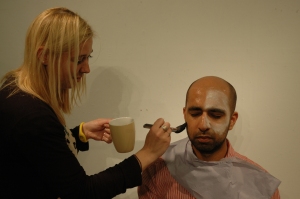Is it possible to forget how to ride a bike?
It always fascinated me that something which shouldn’t be that simple, riding a bike, actually is. But that is not all that fascinates me. It is the bicycle itself, the world’s most utilitarian transport.
The bike is fascinating because wherever you go in the world there is always someone riding a bike. The more I travel the more I see it’s usefulness; London, the Pyrenees, Beijing – all have bikes. Different people with different uses, but many use bikes. I’m not going to give a potted history of the bicycle, as there are many worthwhile texts out there which have devoted thousands of words to it.
Anyway, what does a bike have to do with the museum and why have I chosen it? Well, I’m a keen cyclist. I have cycled all over Europe and there is nothing I love more than getting up early on a Sunday, driving to the countryside and going for a ride. My bike is a Giant Trance. On it I have changed the grips, pedals, big ring, seat clamp and the list goes on. I spend a lot of time thinking of how to make it lighter/faster/more attractive. This is not the case with the bike here in the museum.
It is a perfect example of the utilitarian bike people within industrial Blackburn would own. This sort of bike wasn’t made for pleasure; it was made to get to work. This wasn’t used for weekend touring in the Dordogne. or for thrashing it down the hills of Fort William. Rather than just do a straight historical road test like the clogs or irons I decided to test it against my bike. Which is better?
Seat: Surprisingly comfortable on the oldie, much more comfortable than mine. History 1 – 0 Modern
Suspension: Front and rear suspension on my bike, two springs under the saddle of the old bike. History 1 – 1 Modern
Brakes: Front and rear disc brakes compared to non-existent rim brakes on the boneshaker. History 1 – 2 Modern
Handling: The old bike handles surprisingly well. The geometry of the frame and set-up of the bike meant handling around potholes or playing children would be relatively easy. A conclusive test (around our gallery) couldn’t split the two. Half point each. History 1.5 – 2.5 Modern
Cost: Old bike = Not a lot. Modern Mountain/Road bikes = Bloody expensive. History 2.5 – 2.5 Modern
Fun Factor: The novelty of the old bike meant the ride was a lot of fun. Probably not so fun anywhere the surface isn’t flat. Impossible to do wheelies on too! History 2.5 – 3.5 Modern
In the end the modern bike wins it by a point, but a closely fought contest. If you have memories of trundling around Blackburn on your bike, and the best and worst places to ride them, please put them in the comments. I would love to hear them!




Recent Comments